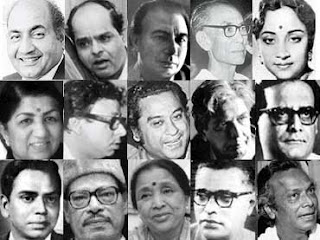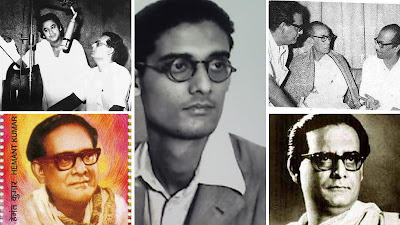PART 6 OF 10: ASIF'S MAGNUM OPUS
Just in terms of sheer numbers, the studios in Madras made more movies per year compared to Bombay. That is because the four South Indian industries were headquartered in Madras till the late eighties and in some years made over three hundred and fifty movies a year. Kodambakkam was teeming with filmy talent.
Legendary lyricists like Kannadasan, Pattukottai Kalyanasundaram, Vaali, Sri Sri, Veturi Sundarama Murthy, Vayalar Ramavarma, ONV Kurup, and RN Jayagopal influenced not just the literature and poetry of their states but shaped their socio-politics.
Speaking of politics, what about the heroes? Well,
the doyens of the South industry: MG Ramachandran, NT Ramarao, Akkinneni Nageswara Rao, Sivaji Ganesan, Rajkumar, and Prem Nazir; and the heroines:
But did these talents come together to produce world class cinema and sow the seeds for the onset of the 'Golden Age' of South Indian cinema? I am not so sure. Some will answer with a resounding yes. After all, for them, 1950-75 epitomized a period when actors, actresses, directors, and musicians became the bedrock of South India's popular culture. No doubt about that. However, (I am going to get into trouble for saying this) I am not sure if they were making path-breaking films - like a 'Pather Panchali' or a 'Bicycle Thieves' or a 'Pyaasa' that shook the earth underneath. The movies from the South, barring a few exceptions, were still defined by loquacious dramas and historicals that were transcribed from stage to celluloid. So, the southern industry's USP was clean, family-based, commercially viable entertainers. And they did not depart from that beaten track till the technicians and artistes unshackled themselves from the clutches of the studio system and went "Indie", which was not till the mid-to-late seventies.
 |
| Bengali directors (L to R): Ritwik Ghatak, Satyajit Ray, Mrinal Sen |
Bengali movies were going through a revolution of their own kind, during this period. They chose quality over quantity. The trifecta: Satyajit Ray, Mrinal Sen, and Ritwik Ghatak, led the movement for cerebral cinema for all of India. Their style of filmmaking influenced scores of Indian filmmakers, especially in the parallel cinema movement of the seventies.
So, there was a case to be made for the 'Golden Age', everywhere movies were being made in India, to varying degrees.
Now let us get back to 1960. The year made a superb thematic start for the entire decade by being called the 'Year of Africa', as seventeen African states gained independence from colonial powers and joined the United Nations. This fueled a global movement for racial equality and political freedoms, through the sixties. Kennedy was elected as the youngest president of the United States and would quickly get embroiled in the Vietnam War. Back in India, the states of Maharashtra and Gujarat were formed after a prolonged struggle.
For the Hindi Film Industry, 1960 will always be a landmark year. The magnum opus, Mughal-e-Azam, was released that year and is still considered to be the grandest and the highest grossing movie (adjusted for inflation) ever made in Indian cinema.
The movie, directed by K Asif, went into production in 1944 but was plagued with difficulties. Numerous production and casting problems bogged the project down and it faced abandonment multiple times. Principal photography for the movie started in 1951 with Dilip Kumar, Madhubala, Prithviraj Kapoor and one of the largest ensemble casts ever assembled in Indian cinema. The film was based on a 1922 play by Imtiaz Ali Taj based on a mythical love affair between Prince Salim (Jahangir) and Anarkali. The movie was a massive labor of love for Asif, who lived and breathed it for fifteen years (out of the forty eight that he lived). Asif directed only two movies in a career spanning twenty five years - 'Phool', his debut, and then 'Mughal-e-Azam'. He half-completed a movie named 'Love and God' based on the love story of Laila and Majnu. This movie was, again, ridden with delays and disasters. Asif died halfway through this project and the half-shot movie was released in 1986, nearly twenty five years after the project went on the floors.
For 'Mughal-e-Azam', Asif roped in nothing but the best of talents and props and spared no expenditure or effort to realize his grand vision. He spent lavishly on the sets and costumes, re-created Mughal courts and battle scenes and depicted the grandeur of Akbar's kingdom and the times. Just the shooting and post-production extended for nine years, partly because he re-shot portions of the movie in color (he faced a mini mutiny with the crew and the distributors when he considered reshooting the entire movie in color!).
Shakil Warsi's 2009 book 'Mughal-E-Azam: An Epic of Eternal Love' is a fascinating read about the making of the movie. This book and other stories from that era indicate the extent to which someone can be obsessed with his profession and craft. Asif could have made ten 'Housefull' or 'Welcome' franchise movies during this time and raked in the moolah for three generations of his family. He did not do that. Instead, he made one 'Mughal-e-Azam' that will be artistically celebrated for nine lives. So, the epiphanic movie question is, who is better: Rohit Shetty or K Asif? (Choose wisely).
The premier, when it happened on August 5, 1960 at the eleven hundred seater, Maratha Mandir, Bombay, was an affair to remember with elephants, music, and regalia. Dilip Kumar (who was Asif's brother-in-law) was conspicuous by his absence owing to personal issues between Asif and him.
Mughal-e-Azam ended up being the highest grossing film of all time, earning over ten crore rupees. Its record was finally broken by Sholay (1975), in absolute terms. We are talking 1960 currency, though. India's GDP was one hundredth of its current value. A plate of Idli in Triplicane Ratna Café cost fifteen paise and a gallery ticket in Maratha Mandir cost a rupee. Inflation-adjusted earnings would place 'Mughal-E-Azam' well above 'Dangal' and 'Bahubali'.
As spectacular as the movie was, it would have been only half as good without the mesmerizing music of Naushad. What a genius he was! Naushad was a Lucknowi by birth and hailed from an orthodox Muslim family. He had learned Hindustani classical music for more than a decade and dabbled with playing the harmonium and tabla and associating himself with a theater company. He ran off to Bombay in his late teens, to follow his passion for music. He got his initial break as an assistant to Khemchand Prakash. He debuted as a music director with 'Nayi Duniya' in 1942. 'Rattan', 'Baiju Bawra', 'Aan', 'Andaz', 'Ganga Jamuna', 'Kohinoor' and many others followed. It is amusing that even after his movies became super hits and earned him a comfortable living, he continued to hide the fact that he was a music composer from his orthodox father who considered music as haram.
Naushad often followed pure classical ragas to compose his music. Whether it is the song you are going to hear now in Raags Darabari Kanada and Durga or 'Madhuban mein Radhika nache' (Kohinoor, 1960) in Hamir, he was the pioneer in bringing Hindustani classical music to celluloid and making it accessible to common folk. The lyrics are by Naushad's frequent collaborator, Shakeel Badayuni.
If you want to see a clearer picture, click the link below.











Comments
Post a Comment